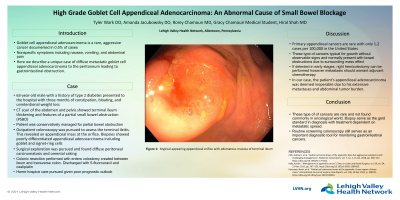Tuesday Poster Session
Category: Colon
P3693 - High Grade Goblet Cell Appendiceal Adenocarcinoma: An Abnormal Cause of Small Bowel Blockage
Tuesday, October 29, 2024
10:30 AM - 4:00 PM ET
Location: Exhibit Hall E

Has Audio
- TW
Tyler Wark, DO
Lehigh Valley Health Network
Macungie, PA
Presenting Author(s)
Tyler Wark, DO1, Amanda Jacubowsky, DO2, Romy Chamoun, MD2, Gracy Chamoun, BS3, Hiral Shah, MD4
1Lehigh Valley Health Network, Macungie, PA; 2Lehigh Valley Health Network, Allentown, PA; 3University of Balamand, Arlington, VA; 4Lvhn, Center Valley, PA
Introduction: Goblet cell appendiceal adenocarcinoma is a rare, aggressive cancer. It is seen in only 0.5% of patients with appendiceal cancer. Patients typically present with features of appendicitis including nausea, vomiting, and abdominal pain. Here we describe a unique case of diffuse metastatic goblet cell appendiceal adenocarcinoma to the peritoneum leading to gastrointestinal obstruction.
Case Description/Methods: A 63-year-old male with a history of type 2 diabetes presented to the hospital with three months of constipation, bloating, and unintentional weight loss. CT scan of the abdomen and pelvis showed terminal ileum thickening and features of a partial small bowel obstruction (PSBO). The patient’s PSBO was conservatively managed, and he was discharged. A follow-up outpatient colonoscopy was pursued to assess the terminal ileitis. This revealed an appendiceal mass at the orifice. Biopsies showed poorly differentiated appendiceal adenocarcinoma including goblet and signet-ring cells. Surgical exploration was pursued and found diffuse peritoneal carcinomatosis and omental caking. With extensive disease, colonic resection was deferred and an enterocolostomy was created between the ileum and transverse colon. Single-agent 5-fluorouracil was initiated outpatient with the eventual addition of oxaliplatin. Over the subsequent months, the patient had multiple hospitalizations that included complications of numerous infections including a left middle cerebral artery stroke. Six months after the initial cancer diagnosis, he met with the palliative care team and pursued home hospice care.
Discussion: Primary appendiceal cancers are rare with only 1.2 cases per 100,000 in the United States. These cancers normally go undetected when patients are asymptomatic. However, acute appendicitis and bowel obstruction can occur due to the tumor's compressive effects on the appendiceal orifice and surrounding tissue. Diagnosis includes a combination of abdominal imaging, colonoscopy, and exploratory laparotomy. Treatment will depend on the TNM classification system with right hemicolectomy as the low-stage disease recommendation. Otherwise, patients will undergo adjuvant chemotherapy. In our case, the patient's appendiceal adenocarcinoma was deemed inoperable due to his extensive metastases and abdominal tumor burden.
Disclosures:
Tyler Wark, DO1, Amanda Jacubowsky, DO2, Romy Chamoun, MD2, Gracy Chamoun, BS3, Hiral Shah, MD4. P3693 - High Grade Goblet Cell Appendiceal Adenocarcinoma: An Abnormal Cause of Small Bowel Blockage, ACG 2024 Annual Scientific Meeting Abstracts. Philadelphia, PA: American College of Gastroenterology.
1Lehigh Valley Health Network, Macungie, PA; 2Lehigh Valley Health Network, Allentown, PA; 3University of Balamand, Arlington, VA; 4Lvhn, Center Valley, PA
Introduction: Goblet cell appendiceal adenocarcinoma is a rare, aggressive cancer. It is seen in only 0.5% of patients with appendiceal cancer. Patients typically present with features of appendicitis including nausea, vomiting, and abdominal pain. Here we describe a unique case of diffuse metastatic goblet cell appendiceal adenocarcinoma to the peritoneum leading to gastrointestinal obstruction.
Case Description/Methods: A 63-year-old male with a history of type 2 diabetes presented to the hospital with three months of constipation, bloating, and unintentional weight loss. CT scan of the abdomen and pelvis showed terminal ileum thickening and features of a partial small bowel obstruction (PSBO). The patient’s PSBO was conservatively managed, and he was discharged. A follow-up outpatient colonoscopy was pursued to assess the terminal ileitis. This revealed an appendiceal mass at the orifice. Biopsies showed poorly differentiated appendiceal adenocarcinoma including goblet and signet-ring cells. Surgical exploration was pursued and found diffuse peritoneal carcinomatosis and omental caking. With extensive disease, colonic resection was deferred and an enterocolostomy was created between the ileum and transverse colon. Single-agent 5-fluorouracil was initiated outpatient with the eventual addition of oxaliplatin. Over the subsequent months, the patient had multiple hospitalizations that included complications of numerous infections including a left middle cerebral artery stroke. Six months after the initial cancer diagnosis, he met with the palliative care team and pursued home hospice care.
Discussion: Primary appendiceal cancers are rare with only 1.2 cases per 100,000 in the United States. These cancers normally go undetected when patients are asymptomatic. However, acute appendicitis and bowel obstruction can occur due to the tumor's compressive effects on the appendiceal orifice and surrounding tissue. Diagnosis includes a combination of abdominal imaging, colonoscopy, and exploratory laparotomy. Treatment will depend on the TNM classification system with right hemicolectomy as the low-stage disease recommendation. Otherwise, patients will undergo adjuvant chemotherapy. In our case, the patient's appendiceal adenocarcinoma was deemed inoperable due to his extensive metastases and abdominal tumor burden.
Disclosures:
Tyler Wark indicated no relevant financial relationships.
Amanda Jacubowsky indicated no relevant financial relationships.
Romy Chamoun indicated no relevant financial relationships.
Gracy Chamoun indicated no relevant financial relationships.
Hiral Shah: Abbvie – Speakers Bureau.
Tyler Wark, DO1, Amanda Jacubowsky, DO2, Romy Chamoun, MD2, Gracy Chamoun, BS3, Hiral Shah, MD4. P3693 - High Grade Goblet Cell Appendiceal Adenocarcinoma: An Abnormal Cause of Small Bowel Blockage, ACG 2024 Annual Scientific Meeting Abstracts. Philadelphia, PA: American College of Gastroenterology.
